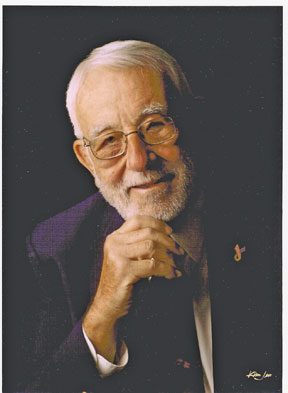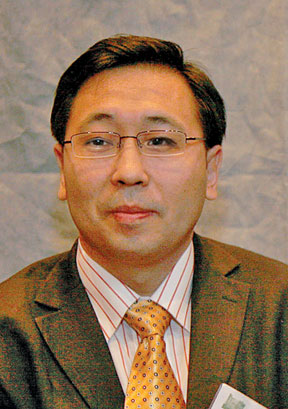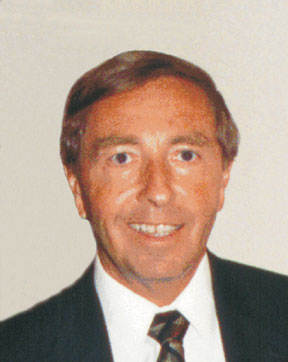This year, three of our members that were evaluated
by the EMC Society Fellow Evaluation Committee were elected to
the IEEE Fellow Grade. In order to quality for election to the
Fellow Grade, a member must have made a significant contribution
to their field of endeavor.
I would like to offer my congratulations to our three new Fellows:
Dr. D. V. Giri, Dr. Lothar O. Hoeft, and Dr. Erping Li for being
elected to the Fellow Grade. These three new Fellows are our EMC
Personality Profiles for this issue of the EMC Newsletter.
Dr. D. V. Giri was elected to the Fellow Grade as a Research Engineer/
Scientist “for contributions to the understanding and analysis
of intense electromagnetic environments interacting with complex
electronic systems.” A complete description of his academic
training and work experience may be seen at his website: www.dvgiri.com
He obtained the B.Sc. from Mysore University, India in 1964, the
B.E. and M.E. degrees from the Indian Institute of Science in
1967 and 1969, the M.S. and Ph.D. degrees from Harvard University
in 1973 and 1975, and a Certificate for the Harvard Introduction
to Business Program in 1981.
 Dr.
D. V. Giri has over 30 years of work experience in the
general field of electromagnetic theory and its applications in
NEMP (Nuclear Electromagnetic Pulse), HPM (High-Power Microwaves),
Lightning, and UWB (Ultra Wideband). Dr. Giri has made significant
technical contributions to the understanding and mitigation of
the high power microwave threat to electronic circuits, equipments
and systems.
Dr.
D. V. Giri has over 30 years of work experience in the
general field of electromagnetic theory and its applications in
NEMP (Nuclear Electromagnetic Pulse), HPM (High-Power Microwaves),
Lightning, and UWB (Ultra Wideband). Dr. Giri has made significant
technical contributions to the understanding and mitigation of
the high power microwave threat to electronic circuits, equipments
and systems.
He taught graduate and undergraduate courses in the Department
of Electrical Engineering and Computer Science at the University
of California, Berkeley campus. He is also an Adjunct Professor
in the Department of Electrical and Computer Engineering, University
of New Mexico, Albuquerque, New Mexico.
Since 1984, he has been a self-employed consultant doing business
as Pro-Tech, in Alamo, California, performing R&D work for
the U.S. Government and industry.
From May 1978 to September 1984, he was a staff scientist at LuTech,
Inc., in Berkeley, California. Prior to his association with LuTech,
Inc., Dr. Giri was a Research Associate for the National Research
Council at the Air Force Research Laboratory (AFRL), Kirtland
AFB, New Mexico, where he conducted research in EMP and other
aspects of electromagnetic theory.
Dr. Giri is a Charter Member of the Electromagnetics Society,
and Associate Member of Commission B, URSI and Vice-Chairman of
Commission E, URSI. He has served on the editorial board of the
Journal of Electromagnetics, published by the Electromagnetics
Society. He has also served as an Associate Editor for the IEEE
Transactions on Electromagnetic Compatibility. The awards committee
of Summa Foundation elected him to the grade of Fellow in 1994
for his contributions to EMP simulator design and HPM antenna
design.
He has coauthored a book titled High-Power Microwave Systems and
Effects published by Taylor and Francis in 1994. Harvard University
Press has published his second book titled High-Power Electromagnetic
Radiators: Nonlethal Weapons and Other Applications in 2004. He
has also published over 100 papers and reports.
 Dr.
Lothar (Bud) O. Hoeft was elected to the Fellow Grade
as an Applications Engineer/Practitioner “for contributions
in demonstrating surface wave transfer impedances to be an intrinsic
electromagnetic shielding characteristic.”
Dr.
Lothar (Bud) O. Hoeft was elected to the Fellow Grade
as an Applications Engineer/Practitioner “for contributions
in demonstrating surface wave transfer impedances to be an intrinsic
electromagnetic shielding characteristic.”
Dr. Hoeft received a Bachelors Degree from the University of Wisconsin
in 1953, a Masters Degree from the University of Wisconsin in
1954, and a Ph.D. Degree from the Pennsylvania State University
in 1961.
He is currently working as a private consultant in the area of
electromagnetic effects. He was a Senior Scientist with BDM International
from 1979 to 1994. From 1975 to 1978, he was the USAF Weapons
Laboratory Scientific and Technical Coordinator of the Chief Scientist’s
Office. From 1971 to 1975, he was with the Air Force European
Office Physical Science Program Office of Aerospace Research and
Development-USAF Weapons Laboratory Chief, Simulation and Laboratory
Support.
Dr. Hoeft used the surface transfer impedance (Zt), which is an
intrinsic property of electromagnetic shields, to characterize
the behavior of a wide range of electromagnetic shielding problems
and to design electromagnetic shields for a wide range of applications
and shielding materials. These include the shielding performance
of cables, ferrite and non-ferrite loaded conduits, cableways,
metallized plastic tapes, knitted wire mesh cable shields and
connectors, and a wide range of equipment boxes and racks. He
also made significant advances in the “art” of performing
Zt measurements at frequencies as high as 1 GHz.
Dr. Hoeft’s work has influenced the development of more
effective cable and connector shielding and has also influenced
the manner in which the Air Force monitors the shielding of aircraft.
He has published a number of technical papers related to his work.
He has been active in the IEEE EMC Society as a Distinguished
Lecturer and as a member of the Shielding Artifact Working Group
(TC-4).
In 2005, Dr. Hoeft was awarded Honorary Life Membership in the
IEEE EMC Society “for over two decades of electrical effects
analysis, experimentation and reporting particularly in connection
to cable and connector shielding, as well as professional support
of various EMC Society Committees and as an EMC Society Distinguished
Lecturer.”
 Dr.
Erping Li was elected to the Fellow Grade as a Research
Engineer/ Scientist “for contributions to electromagnetic
modeling and simulation with applications in high speed electronics,
EMC/EMI and signal integrity.”
Dr.
Erping Li was elected to the Fellow Grade as a Research
Engineer/ Scientist “for contributions to electromagnetic
modeling and simulation with applications in high speed electronics,
EMC/EMI and signal integrity.”
Dr. Li received a Bachelors Degree from Hebeai University of Technology
in 1983, a Masters Degree in Electrical Engineering from Xian
Jiao Tong University in 1986, and a Ph.D. in Electrical Engineering
from Sheffield Hallam University in 1992.
Since 2003, Dr. Li has worked for the Electromagnetic and Electronics
System Department, Institute for High Performance Computing, in
Singapore as a Senior Scientist and Senior R&D Manager. He
has also worked at several universities.
Dr. Li has made outstanding contributions to the field of computational
electromagnetics (EM) that resulted in novel simulation techniques
with applications in EMC/EMI, high speed electronic interconnects
and signal integrity. He developed practical engineering solutions
by finding creative and innovative ways to reduce the computational
modeling effort. His groundbreaking algorithms have been cast
into software packages used by industry in the analysis and design
of complex high-speed electronic packaging considering power and
signal integrity, and solving general EMI/EMC problems. His work
has significantly advanced the understanding and the state-of-the-art
in the modeling and design of mixed-signal integrated circuits,
their packaging, and the hybridization of EM algorithms for efficient
simulation of EMC problems in large-scale systems.
His achievements include:
• Development of a unique top-down approach for accurate
and efficient modeling of electromagnetic susceptibility of electronic
systems
• Introduction of a hybrid macro model FDTD-mixed potential
integral equation method for EMI and signal integrity problems
in multilayer high-density PCB packages
• Establishment of solution methods for large-scale and
macroscopic problems by developing an efficient hybrid fast multipole
technique coupled with the Finite Element Method and ray-tracing
method
• Spearheaded breakthrough solutions for testing techniques
in reverberation chambers, such as moveable directly energized
electronic stirrers instead of conventional stirring techniques.
• Authored and co-authored over 120 technical papers for
international journals and conferences. He holds one US and one
Singapore patent. Three more patent applications are filed with
the US patent office.
In addition to his technical achievements, Dr. Li has made other
contributions to his profession. He was co-founder of the IEEE
EMC Singapore Chapter in 2001. He served as Chapter Vice-Chair
from 2001 to 2004 and Chapter Chair from 2005 to 2006. Under his
leadership, the Chapter received the Most Improved Chapter Award
in 2005. He was the organizer and President of the 17th EMC Zurich
Symposium in Singapore in 2006. Dr. Li has been involved in starting
a major EMC Symposium in the Asia-Pacific region in collaboration
with EMC Zurich. He has been involved in organizing 12 international
conferences and served as technical program chair, session chair
and technical program committee member on numerous international
conferences and workshops. Dr. Li received the IEEE EMC Society
Technical Achievement Award in 2006. EMC
 EMC
Personality Profiles
EMC
Personality Profiles Dr.
D. V. Giri has over 30 years of work experience in the
general field of electromagnetic theory and its applications in
NEMP (Nuclear Electromagnetic Pulse), HPM (High-Power Microwaves),
Lightning, and UWB (Ultra Wideband). Dr. Giri has made significant
technical contributions to the understanding and mitigation of
the high power microwave threat to electronic circuits, equipments
and systems.
Dr.
D. V. Giri has over 30 years of work experience in the
general field of electromagnetic theory and its applications in
NEMP (Nuclear Electromagnetic Pulse), HPM (High-Power Microwaves),
Lightning, and UWB (Ultra Wideband). Dr. Giri has made significant
technical contributions to the understanding and mitigation of
the high power microwave threat to electronic circuits, equipments
and systems. Dr.
Lothar (Bud) O. Hoeft was elected to the Fellow Grade
as an Applications Engineer/Practitioner “for contributions
in demonstrating surface wave transfer impedances to be an intrinsic
electromagnetic shielding characteristic.”
Dr.
Lothar (Bud) O. Hoeft was elected to the Fellow Grade
as an Applications Engineer/Practitioner “for contributions
in demonstrating surface wave transfer impedances to be an intrinsic
electromagnetic shielding characteristic.” Dr.
Erping Li was elected to the Fellow Grade as a Research
Engineer/ Scientist “for contributions to electromagnetic
modeling and simulation with applications in high speed electronics,
EMC/EMI and signal integrity.”
Dr.
Erping Li was elected to the Fellow Grade as a Research
Engineer/ Scientist “for contributions to electromagnetic
modeling and simulation with applications in high speed electronics,
EMC/EMI and signal integrity.”